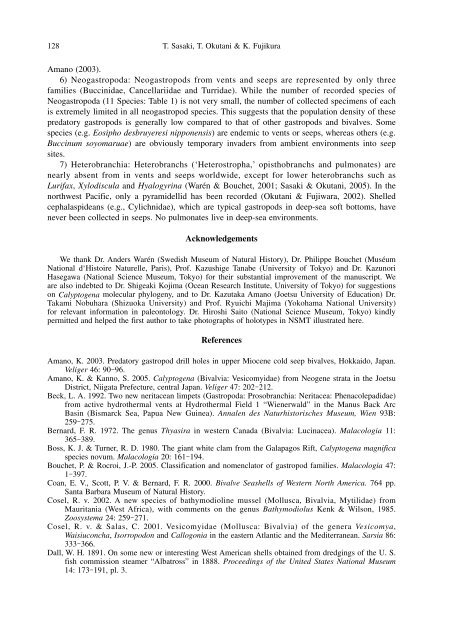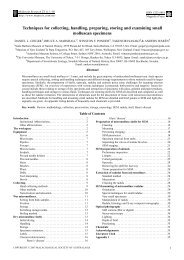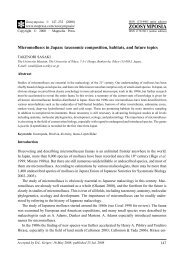Molluscs from Hydrothermal Vents and Cold Seeps in Japan: A ...
Molluscs from Hydrothermal Vents and Cold Seeps in Japan: A ...
Molluscs from Hydrothermal Vents and Cold Seeps in Japan: A ...
Create successful ePaper yourself
Turn your PDF publications into a flip-book with our unique Google optimized e-Paper software.
128T. Sasaki, T. Okutani & K. FujikuraAmano (2003).6) Neogastropoda: Neogastropods <strong>from</strong> vents <strong>and</strong> seeps are represented by only threefamilies (Bucc<strong>in</strong>idae, Cancellariidae <strong>and</strong> Turridae). While the number of recorded species ofNeogastropoda (11 Species: Table 1) is not very small, the number of collected specimens of eachis extremely limited <strong>in</strong> all neogastropod species. This suggests that the population density of thesepredatory gastropods is generally low compared to that of other gastropods <strong>and</strong> bivalves. Somespecies (e.g. Eosipho desbruyeresi nipponensis) are endemic to vents or seeps, whereas others (e.g.Bucc<strong>in</strong>um soyomaruae) are obviously temporary <strong>in</strong>vaders <strong>from</strong> ambient environments <strong>in</strong>to seepsites.7) Heterobranchia: Heterobranchs (‘Heterostropha,’ opisthobranchs <strong>and</strong> pulmonates) arenearly absent <strong>from</strong> <strong>in</strong> vents <strong>and</strong> seeps worldwide, except for lower heterobranchs such asLurifax, Xylodiscula <strong>and</strong> Hyalogyr<strong>in</strong>a (Warén & Bouchet, 2001; Sasaki & Okutani, 2005). In thenorthwest Pacific, only a pyramidellid has been recorded (Okutani & Fujiwara, 2002). Shelledcephalaspideans (e.g., Cylichnidae), which are typical gastropods <strong>in</strong> deep-sea soft bottoms, havenever been collected <strong>in</strong> seeps. No pulmonates live <strong>in</strong> deep-sea environments.AcknowledgementsWe thank Dr. Anders Warén (Swedish Museum of Natural History), Dr. Philippe Bouchet (MuséumNational d’Histoire Naturelle, Paris), Prof. Kazushige Tanabe (University of Tokyo) <strong>and</strong> Dr. KazunoriHasegawa (National Science Museum, Tokyo) for their substantial improvement of the manuscript. Weare also <strong>in</strong>debted to Dr. Shigeaki Kojima (Ocean Research Institute, University of Tokyo) for suggestionson Calyptogena molecular phylogeny, <strong>and</strong> to Dr. Kazutaka Amano (Joetsu University of Education) Dr.Takami Nobuhara (Shizuoka University) <strong>and</strong> Prof. Ryuichi Majima (Yokohama National University)for relevant <strong>in</strong>formation <strong>in</strong> paleontology. Dr. Hiroshi Saito (National Science Museum, Tokyo) k<strong>in</strong>dlypermitted <strong>and</strong> helped the first author to take photographs of holotypes <strong>in</strong> NSMT illustrated here.ReferencesAmano, K. 2003. Predatory gastropod drill holes <strong>in</strong> upper Miocene cold seep bivalves, Hokkaido, <strong>Japan</strong>.Veliger 46: 90-96.Amano, K. & Kanno, S. 2005. Calyptogena (Bivalvia: Vesicomyidae) <strong>from</strong> Neogene strata <strong>in</strong> the JoetsuDistrict, Niigata Prefecture, central <strong>Japan</strong>. Veliger 47: 202-212.Beck, L. A. 1992. Two new neritacean limpets (Gastropoda: Prosobranchia: Neritacea: Phenacolepadidae)<strong>from</strong> active hydrothermal vents at <strong>Hydrothermal</strong> Field 1 “Wienerwald” <strong>in</strong> the Manus Back ArcBas<strong>in</strong> (Bismarck Sea, Papua New Gu<strong>in</strong>ea). Annalen des Naturhistorisches Museum, Wien 93B:259-275.Bernard, F. R. 1972. The genus Thyasira <strong>in</strong> western Canada (Bivalvia: Luc<strong>in</strong>acea). Malacologia 11:365-389.Boss, K. J. & Turner, R. D. 1980. The giant white clam <strong>from</strong> the Galapagos Rift, Calyptogena magnificaspecies novum. Malacologia 20: 161-194.Bouchet, P. & Rocroi, J.-P. 2005. Classification <strong>and</strong> nomenclator of gastropod families. Malacologia 47:1-397.Coan, E. V., Scott, P. V. & Bernard, F. R. 2000. Bivalve Seashells of Western North America. 764 pp.Santa Barbara Museum of Natural History.Cosel, R. v. 2002. A new species of bathymodiol<strong>in</strong>e mussel (Mollusca, Bivalvia, Mytilidae) <strong>from</strong>Mauritania (West Africa), with comments on the genus Bathymodiolus Kenk & Wilson, 1985.Zoosystema 24: 259-271.Cosel, R. v. & Salas, C. 2001. Vesicomyidae (Mollusca: Bivalvia) of the genera Vesicomya,Waisiuconcha, Isorropodon <strong>and</strong> Callogonia <strong>in</strong> the eastern Atlantic <strong>and</strong> the Mediterranean. Sarsia 86:333-366.Dall, W. H. 1891. On some new or <strong>in</strong>terest<strong>in</strong>g West American shells obta<strong>in</strong>ed <strong>from</strong> dredg<strong>in</strong>gs of the U. S.fish commission steamer “Albatross” <strong>in</strong> 1888. Proceed<strong>in</strong>gs of the United States National Museum14: 173-191, pl. 3.




